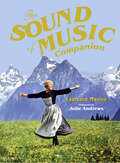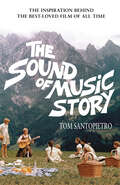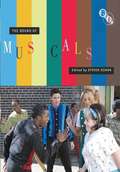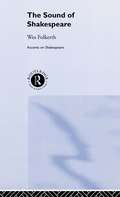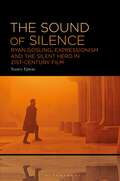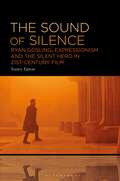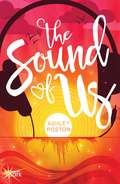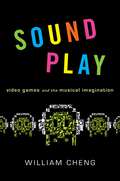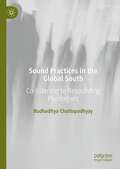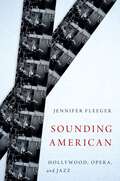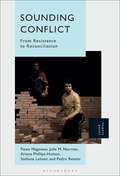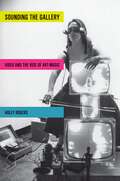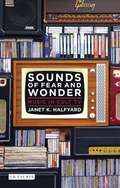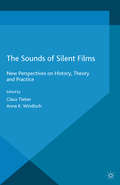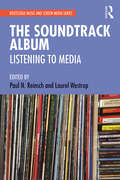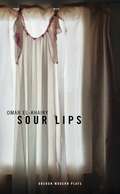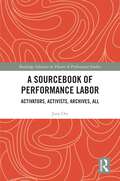- Table View
- List View
The Sound of Music Companion: The Official Companion To The World's Most Beloved Musical
by Laurence MaslonThe definitive book on the world's most beloved musical, TheSound of Music Companion charts the incredible and enduring story of Maria von Trapp and her story over the last hundred years – from Maria's birth in Vienna in 1905 to the 50th anniversary of the film's release in 2015.
The Sound of Music Story: How One Young Nun, One Handsome Austrian Captain, And Seven Singing Von Trapp Children Inspired The Most Beloved Film Of All Time
by Tom SantopietroIn March 1965 the film of The Sound of Music was released - and the love affair between moviegoers and the classic Rodgers and Hammerstein musical began.Rarely has a film so captured the love and imagination of the public, blending history, music, Austrian location filming, heartfelt emotion and the yodelling of Julie Andrews into a monster hit. Now, Tom Santopietro has written the ultimate "Sound of Music" fan book with all the inside information - the real-life story of the Von Trapps, the behind the dramas of the casting - we all know that Julie Andrews and Christopher Plummer played Maria and Captain Von Trapp, but who else had been considered? – and the many hazards of shooting the film on location. We learn how some of the iconic songs came into being and what the actors really thought of it.Tom Santopietro knows all and will tell all. The Sound of Music Story is a book for everyone who cherishes this classic musical.
The Sound of Musicals
by Steven CohanDespite having had its obituary written many times, the movie musical remains a flourishing twenty-first century form, and as this volume demonstrates, one that exists far beyond the confines of Broadway and Hollywood. The Sound of Musicals examines the films, stars, issues and traditions of the genre from the 1930s to the present day. Featuring sixteen original essays by leading international scholars, this illuminating collection addresses the complex history and global variety of the movie musical, and considers the delight and passionate engagement that musicals continue to inspire in audiences around the world.The contributors address key issues for understanding the movie musical: questions of genre and generic traditions; questions of history, bringing fresh perspectives to a consideration of Classical Hollywood musicals; and the musical beyond Hollywood, looking at alternatives to the Hollywood model from the 'New Hollywood' and American independent cinema to Bollywood and other national musical traditions. Individual chapters consider key musical stars such as Frank Sinatra, Julie Andrews and Barbra Streisand; film-makers including Robert Altman and Christophe Honoré, and classic musicals such as South Pacific (1958) and Hairspray (1988). In his introduction to the volume, Steven Cohan addresses the significance and enduring appeal of this multi-faceted genre, and considers its recent renaissance with movies such as the High School Musical franchise, and the success of the television series Glee.
The Sound of Shakespeare (Accents on Shakespeare)
by Wes FolkerthThe 'Sound of Shakespeare' reveals the surprising extent to which Shakespeare's art is informed by the various attitudes, beliefs, practices and discourses that pertained to sound and hearing in his culture. In this engaging study, Wes Folkerth develops listening as a critical practice, attending to the ways in which Shakespeare's plays express their author's awareness of early modern associations between sound and particular forms of ethical and aesthetic experience. Through readings of the acoustic representation of deep subjectivity in Richard III, of the 'public ear' in Antony and Cleopatra, the receptive ear in Coriolanus, the grotesque ear in A Midsummer Night's Dream, the 'greedy ear' in Othello, and the 'willing ear' in Measure for Measure, Folkerth demonstrates that by listening to Shakespeare himself listening, we derive a fuller understanding of why his works continue to resonate so strongly with is today.
The Sound of Shakespeare (Accents on Shakespeare)
by Wes FolkerthThe 'Sound of Shakespeare' reveals the surprising extent to which Shakespeare's art is informed by the various attitudes, beliefs, practices and discourses that pertained to sound and hearing in his culture. In this engaging study, Wes Folkerth develops listening as a critical practice, attending to the ways in which Shakespeare's plays express their author's awareness of early modern associations between sound and particular forms of ethical and aesthetic experience. Through readings of the acoustic representation of deep subjectivity in Richard III, of the 'public ear' in Antony and Cleopatra, the receptive ear in Coriolanus, the grotesque ear in A Midsummer Night's Dream, the 'greedy ear' in Othello, and the 'willing ear' in Measure for Measure, Folkerth demonstrates that by listening to Shakespeare himself listening, we derive a fuller understanding of why his works continue to resonate so strongly with is today.
The Sound of Silence: Ryan Gosling, Expressionism and the Silent Hero in 21st-Century Film
by Nancy EptonThe Sound of Silence explores how non-verbal communication in film, shown primarily through the acting of Ryan Gosling, provides an expressive space in which passive audience viewing is made more active by removing the expository signifier of dialogue. The German Expressionist era may have been brief, but the shadows cast since its end nonetheless loom large. The silhouetted, cigar-wielding men of film noir and their respectively dark, doom-laden haunts mirror the angst-inducing atmospheres of their forebearers, while also introducing the now-familiar figure of the silent hero. Considering the numerous silent hero actors in film history, there's one that stands out in the 21st century like no other: Ryan Gosling. His later career has seen some of the most iconic silent heroes of the past decade, with films such as Drive, Only God Forgives, Blade Runner 2049 and First Man cementing him as the go-to guy for a monosyllabic, taciturn and moody hero whose actions speak louder than words. This book argues that it is Gosling's expressive capabilities that keep audiences compelled by his performances. With the use of non-verbal silence – combined with its counterbalance, sound – a more active, emotive audience response can be achieved. Looking further into this idea through theorists such as Michel Chion and Susan Sontag, the book demonstrates that the sound of silence is one of the most meaningful cinematic sounds of all.
The Sound of Silence: Ryan Gosling, Expressionism and the Silent Hero in 21st-Century Film
by Nancy EptonThe Sound of Silence explores how non-verbal communication in film, shown primarily through the acting of Ryan Gosling, provides an expressive space in which passive audience viewing is made more active by removing the expository signifier of dialogue. The German Expressionist era may have been brief, but the shadows cast since its end nonetheless loom large. The silhouetted, cigar-wielding men of film noir and their respectively dark, doom-laden haunts mirror the angst-inducing atmospheres of their forebearers, while also introducing the now-familiar figure of the silent hero. Considering the numerous silent hero actors in film history, there's one that stands out in the 21st century like no other: Ryan Gosling. His later career has seen some of the most iconic silent heroes of the past decade, with films such as Drive, Only God Forgives, Blade Runner 2049 and First Man cementing him as the go-to guy for a monosyllabic, taciturn and moody hero whose actions speak louder than words. This book argues that it is Gosling's expressive capabilities that keep audiences compelled by his performances. With the use of non-verbal silence – combined with its counterbalance, sound – a more active, emotive audience response can be achieved. Looking further into this idea through theorists such as Michel Chion and Susan Sontag, the book demonstrates that the sound of silence is one of the most meaningful cinematic sounds of all.
The Sound of Us
by Ashley PostonThis romance from the author of Geekerella and Heart of Iron is the hilarious and heartwarming story of a classic-rock girl and a pop-star boy . . .America's favorite pop band, Roman Holiday, is done, dead, and so totally last year. For eighteen-year-old rockoholic Junie Baltimore, this is music to her ears. But when she discovers their sexy ex-lead singer hiding out on the boardwalk, her summer vacation becomes the cover story of the year.She's willing to keep him a secret, but when a sleazy paparazzo offers her the cash she needs to save the bar her father left behind, could she sell out for the chance to save her future? Who is she kidding? That's a no-brainer...but she never planned on falling head over heels for the lead singer.
Sound Play: Video Games and the Musical Imagination (Oxford Music / Media)
by William ChengVideo games open portals to fantastical worlds where imaginative play and enchantment prevail. These virtual settings afford us considerable freedom to act out with relative impunity. Or do they? Sound Play explores the aesthetic, ethical, and sociopolitical stakes of people's creative engagements with gaming's audio phenomena-from sonorous violence to synthesized operas, from democratic music-making to vocal sexual harassment. William Cheng shows how video games empower their designers, composers, players, critics, and scholars to tinker (often transgressively) with practices and discourses of music, noise, speech, and silence. Faced with collisions between utopian and alarmist stereotypes of video games, Sound Play synthesizes insights across musicology, sociology, anthropology, communications, literary theory, philosophy, and additional disciplines. With case studies spanning Final Fantasy VI, Silent Hill, Fallout 3, The Lord of the Rings Online, and Team Fortress 2, this book insists that what we do in there-in the safe, sound spaces of games-can ultimately teach us a great deal about who we are and what we value (musically, culturally, humanly) out here. Foreword by Richard Leppert Video Games Live cover image printed with permission from Tommy Tallarico
Sound Play: Video Games and the Musical Imagination (Oxford Music / Media)
by William ChengVideo games open portals to fantastical worlds where imaginative play and enchantment prevail. These virtual settings afford us considerable freedom to act out with relative impunity. Or do they? Sound Play explores the aesthetic, ethical, and sociopolitical stakes of people's creative engagements with gaming's audio phenomena-from sonorous violence to synthesized operas, from democratic music-making to vocal sexual harassment. William Cheng shows how video games empower their designers, composers, players, critics, and scholars to tinker (often transgressively) with practices and discourses of music, noise, speech, and silence. Faced with collisions between utopian and alarmist stereotypes of video games, Sound Play synthesizes insights across musicology, sociology, anthropology, communications, literary theory, philosophy, and additional disciplines. With case studies spanning Final Fantasy VI, Silent Hill, Fallout 3, The Lord of the Rings Online, and Team Fortress 2, this book insists that what we do in there-in the safe, sound spaces of games-can ultimately teach us a great deal about who we are and what we value (musically, culturally, humanly) out here. Foreword by Richard Leppert Video Games Live cover image printed with permission from Tommy Tallarico
Sound Practices in the Global South: Co-listening to Resounding Plurilogues
by Budhaditya ChattopadhyayThis book develops a comprehensive understanding of the unique sound worlds of key regions in the Global South, through an auto-ethnographic method of self-reflective conversations with prominent sound practitioners from South Asia, Africa, the Middle East and Latin America. The conversations navigate various trajectories of sound practices, illuminating intricate sonic processes of listening, thinking through sounds, ideating, exposing, and performing with sound. This collection of conversations constitutes the main body of the book, including critical and scholarly commentaries on aural cultures, sound theory and production. The book builds a ground-up approach to nurturing knowledge about aural cultures and sonic aesthetics, moving beyond the Eurocentric focus of contemporary sound studies. Instead of understanding sound practices through consumption and entertainment, they are explored as complex cultural and aesthetic systems, working directly with the practitioners themselves, who largely contribute to the development of the sonic methodologies. Refocusing on the working methods of practitioners, the book reveals a tension between the West’s predominant colonial-consumerist cultures, and the collective desires of practitioners to resist colonial models of listening by expressing themselves in terms of their arts and craft, and their critical faculties.Conversations with: Clarence Barlow, Sandeep Bhagwati, Rajesh K. Mehta, Sharif Sehnaoui, Ximena Alarcón Díaz, Hardi Kurda, Mario de Vega, Luka Mukhavele, Khyam Allami, Cedrik Fermont, Khaled Kaddal, David Velez, Juan Duarte, Youmna Saba, Abdellah M. Hassak, Mariana Marcassa, Amanda Gutiérrez, Syma Tariq, Alma Laprida, Siamak Anvari, Mohamad Safa, Debashis Sinha, Zouheir Atbane, Constanza Bizraelli, Jatin Vidyarthi, Joseph Kamaru, Surabhi Saraf, Isuru Kumarasinghe, Hemant Sreekumar.
Sounding American: Hollywood, Opera, and Jazz (Oxford Music / Media)
by Jennifer FleegerSounding American: Hollywood, Opera, and Jazz tells the story of the interaction between musical form, film technology, and ideas about race, ethnicity, and the nation during the American cinema's conversion to sound. Contrary to most accepted narratives about the conversion, which tend to explain the competition between the Hollywood studios' film sound technologies in qualitative and economic terms, this book argues that the battle between disc and film sound was waged primarily in an aesthetic realm. Opera and jazz in particular, though long neglected in studies of the film score, were extremely important in defining the scope of the American soundtrack, not only during the conversion, but also once sound had been standardized. Examining studio advertisements, screenplays, scores, and the films themselves, author Jennifer Fleeger concentrates on the interactions between musical form and film technology, arguing that each of the major studios appropriated opera and jazz in a unique way in order to construct its own version of an ideal American voice. Traditional histories of Hollywood film music have tended to concentrate on the unity of the score, a model that assumes a passive spectator. Sounding American claims that the classical Hollywood film is essentially an illustrated jazz-opera with a musical structure that encourages an active form of listening and viewing in order to make sense of what is ultimately a fragmentary text.
Sounding Conflict: From Resistance to Reconciliation
by Fiona Magowan Pedro Rebelo Stefanie Lehner Julie M. Norman Ariana Phillips-HuttonSound, music and storytelling are important tools of resistance, resilience and reconciliation in creative practice from protracted conflict to post-conflict contexts. When they are used in a socially engaged participatory capacity, they can create counter-narratives to conflict. Based on original research in three continents, this book advances an interdisciplinary, comparative approach to exploring the role of sonic and creative practices in addressing the effects of conflict. Each case study illustrates how participatory arts genres are variously employed by musicians, arts facilitators, theatre practitioners, community activists and other stakeholders as a means of 'strategic creativity' to transform trauma and promote empowerment. This research further highlights the complex dynamics of delivering and managing creativity among those who have experienced violence, as they seek opportunities to generate alternative arenas for engagement, healing and transformation.
Sounding Conflict: From Resistance to Reconciliation
by Fiona Magowan Pedro Rebelo Stefanie Lehner Julie M. Norman Ariana Phillips-HuttonSound, music and storytelling are important tools of resistance, resilience and reconciliation in creative practice from protracted conflict to post-conflict contexts. When they are used in a socially engaged participatory capacity, they can create counter-narratives to conflict. Based on original research in three continents, this book advances an interdisciplinary, comparative approach to exploring the role of sonic and creative practices in addressing the effects of conflict. Each case study illustrates how participatory arts genres are variously employed by musicians, arts facilitators, theatre practitioners, community activists and other stakeholders as a means of 'strategic creativity' to transform trauma and promote empowerment. This research further highlights the complex dynamics of delivering and managing creativity among those who have experienced violence, as they seek opportunities to generate alternative arenas for engagement, healing and transformation.
Sounding the Gallery: Video and the Rise of Art-Music (Oxford Music / Media)
by Holly RogersBecoming commercially available in the mid 1960s, video quickly became integral to the intense experimentalism of New York City's music and art scenes. The medium was able to record image and sound at the same time, which allowed composers to visualize their music and artists to sound their images. But as well as creating unprecedented forms of audiovisuality, video work also producedinteractive spaces that questioned conventional habits of music and art consumption. This book explores the first decade of creative video work, focusing on the ways in which video technology was used to dissolve the boundaries between art and music.
Sounding the Gallery: Video and the Rise of Art-Music (Oxford Music / Media)
by Holly RogersBecoming commercially available in the mid 1960s, video quickly became integral to the intense experimentalism of New York City's music and art scenes. The medium was able to record image and sound at the same time, which allowed composers to visualize their music and artists to sound their images. But as well as creating unprecedented forms of audiovisuality, video work also producedinteractive spaces that questioned conventional habits of music and art consumption. This book explores the first decade of creative video work, focusing on the ways in which video technology was used to dissolve the boundaries between art and music.
Sounds of Fear and Wonder: Music in Cult TV (Investigating Cult TV)
by Janet K. HalfyardHow does music enrich and define cult television series? The book analyses theme tunes and scoring on television to reveal how composers construct a series' identity using musical idioms and instruments. Characters and plot developments, similarly, are enhanced by their musical accompaniment. The different scoring strategies employed in science fiction and horror-based genres, comprising for example Star Trek or Dr. Who, are considered alongside cult shows set in our reality, such as Dexter, The Sopranos and Queer as Folk. These discussions are complimented by in-depth case studies of musical approaches in three high-profile series: Buffy the Vampire Slayer, Battlestar Galactica and Lost. Written from a musicological standpoint but fully accessible to non-musicologists, the book significantly advances television and music studies.
The Sounds of Silent Films: New Perspectives on History, Theory and Practice (Palgrave Studies in Audio-Visual Culture)
by Claus Tieber Anna Katharina WindischThe Sounds of Silent Films is a unique collection of investigatory and theoretical essays that, for the first time, unite up-to-date research on the complex historical performance practices of silent film accompaniment with in-depth analyses of relevant case studies.
The Soundtrack Album: Listening to Media
by Paul Reinsch Laurel WestrupThe Soundtrack Album: Listening to Media offers the first sustained exploration of the soundtrack album as a distinctive form of media. Soundtrack albums have been part of our media and musical landscape for decades, enduring across formats from vinyl and 8-tracks to streaming playlists. This book makes the case that soundtrack albums are more than promotional tools for films, television shows, or video games— they are complex media texts that reward a detailed analysis. The collection’s contributors explore a diverse range of soundtrack albums, from Super Fly to Stranger Things, revealing how these albums change our understanding of the music and film industries and the audio-visual relationships that drive them. An excellent resource for students of Music, Media Studies, and Film/Screen Media courses, The Soundtrack Album offers interdisciplinary perspectives and opens new areas for exploration in music and media studies.
The Soundtrack Album: Listening to Media
by Paul Reinsch Laurel WestrupThe Soundtrack Album: Listening to Media offers the first sustained exploration of the soundtrack album as a distinctive form of media. Soundtrack albums have been part of our media and musical landscape for decades, enduring across formats from vinyl and 8-tracks to streaming playlists. This book makes the case that soundtrack albums are more than promotional tools for films, television shows, or video games— they are complex media texts that reward a detailed analysis. The collection’s contributors explore a diverse range of soundtrack albums, from Super Fly to Stranger Things, revealing how these albums change our understanding of the music and film industries and the audio-visual relationships that drive them. An excellent resource for students of Music, Media Studies, and Film/Screen Media courses, The Soundtrack Album offers interdisciplinary perspectives and opens new areas for exploration in music and media studies.
Soundtrack from Saturday Night Fever (33 1/3 Oceania)
by Clinton WalkerSaturday Night Fever is simultaneously one of the biggest-selling albums of all time and one of the most reviled. How can a record create such a polarizing reaction? Australian writer Clinton Walker attempts to answer that question and finds that, among other things, a certain seemingly unlikely Australianness is part of the reason. Fever was a supernova for disco, for the Bee Gees, for the domineering Robert Stigwood, producer of the film and its true auteur, and for the entire record business. This book traces all the interdependent convolutions that fed into the film and its music – not least the Australian roots that Stigwood and Gibb brothers shared, which gave them an Otherness and almost gormless, shape-shifting self-determination – and it finds that sometimes great art can be made by a committee ... that sometimes, five songs are enough to change the world.
Soundtrack from Saturday Night Fever (33 1/3 Oceania)
by Clinton WalkerSaturday Night Fever is simultaneously one of the biggest-selling albums of all time and one of the most reviled. How can a record create such a polarizing reaction? Australian writer Clinton Walker attempts to answer that question and finds that, among other things, a certain seemingly unlikely Australianness is part of the reason. Fever was a supernova for disco, for the Bee Gees, for the domineering Robert Stigwood, producer of the film and its true auteur, and for the entire record business. This book traces all the interdependent convolutions that fed into the film and its music – not least the Australian roots that Stigwood and Gibb brothers shared, which gave them an Otherness and almost gormless, shape-shifting self-determination – and it finds that sometimes great art can be made by a committee ... that sometimes, five songs are enough to change the world.
Sour Lips (Oberon Modern Plays)
by Omar El-KhairyI was still living as an Arab Muslim in America. I struggled with coming out to friends and family, and so I decided to come back to Syria. It hasn’t been easy. But we are here, just as we are everywhere.DAMASCUS 18:00 – Amina was walking near Fares Al-Khouri Street when three armed men seized her. According to an eyewitness, Amina was bustled into ared Dacia Logan with a bumper sticker of Basel Assad. The men are assumed to be members of the Ba’ath Partymilitia or one of the security services. Amina’s present location is still unknown. Following the story of Amina Arraf, the blogger known as ‘A Gay Girl In Damascus’, and the events fomented by the media’s coverage of her kidnapping, Sour Lips fuses fantasy and non-fiction to create its own speculative narrative.This play is a fictional account, inspired by both a hoax and its true story. It contains extracts from Tom MacMaster’s weblog, A Gay Girl in Damascus. However, the characters, timelines and incidents have been changed for dramatic purposes. In some cases, fictitious characters and incidents have been further added to the narrative, and the words are those imagined by the author. The play should not be understood as either a biography or factual account.
A Sourcebook of Performance Labor: Activators, Activists, Archives, All (Routledge Advances in Theatre & Performance Studies)
by Joey OrrA Sourcebook of Performance Labor presents the views and experiences of collaborators in other artists’ works. This book reorients well-known works of contemporary performance and social practice around the workers who have shaped, enacted, and supported them. It emerges from perspectives on maintenance, care, affective labor, and the knowledges created and preserved through gesture and intersubjectivity. This compilation of interviews is filled with the voices of collaborators in notable works attributed to established contemporary artists, including Francis Alÿs, Tania Bruguera, Suzanne Lacy, Ernesto Pujol, Asad Raza, Dread Scott, and Tino Sehgal. In the spirit of the artworks under discussion, this book reinvests in the possibilities for art as a collective effort to explore new ways of finding ourselves in others and others in ourselves. The Sourcebook collection is a contribution for further theorizing a largely unaddressed perspective in contemporary art. This collection will be of great interest to students and scholars in performance studies and art history.
A Sourcebook of Performance Labor: Activators, Activists, Archives, All (Routledge Advances in Theatre & Performance Studies)
by Joey OrrA Sourcebook of Performance Labor presents the views and experiences of collaborators in other artists’ works. This book reorients well-known works of contemporary performance and social practice around the workers who have shaped, enacted, and supported them. It emerges from perspectives on maintenance, care, affective labor, and the knowledges created and preserved through gesture and intersubjectivity. This compilation of interviews is filled with the voices of collaborators in notable works attributed to established contemporary artists, including Francis Alÿs, Tania Bruguera, Suzanne Lacy, Ernesto Pujol, Asad Raza, Dread Scott, and Tino Sehgal. In the spirit of the artworks under discussion, this book reinvests in the possibilities for art as a collective effort to explore new ways of finding ourselves in others and others in ourselves. The Sourcebook collection is a contribution for further theorizing a largely unaddressed perspective in contemporary art. This collection will be of great interest to students and scholars in performance studies and art history.
